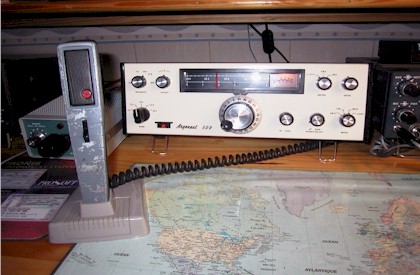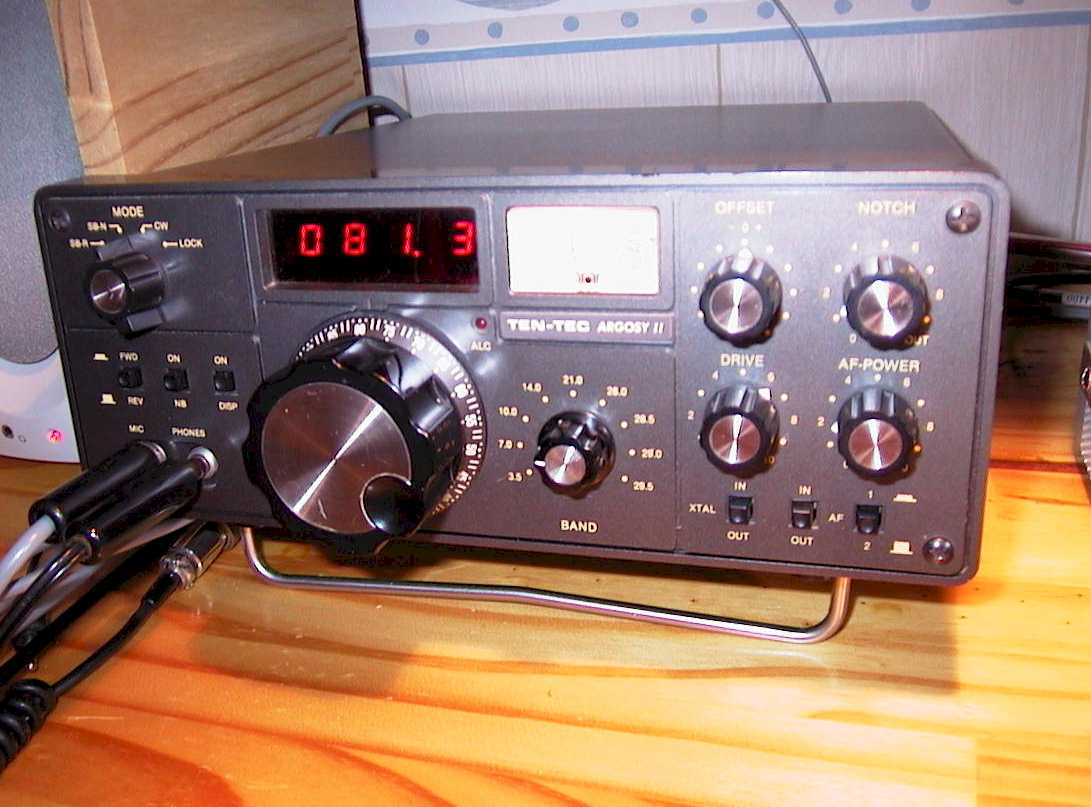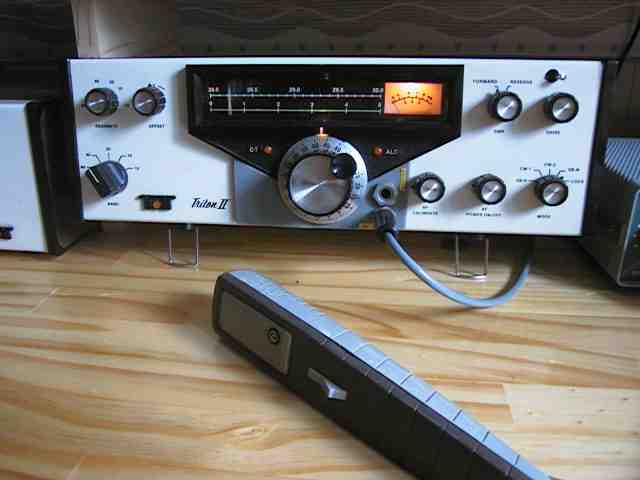direct links to TEN TEC collection antennas mySDR all SDR WSPR myshack retour accueil home
Why Ten Tec: a childhood dream, about the year 75 (the last century!) appeared the Argonaut 505 in our national magazines, too expensive at the time, I naturally sought after decades of work, family, etc. ... Ten Tec is above all a brand that manufactures for amateurs of 'toys' powerful but somewhat rustic rigs (eg packaging), which make them sympathetic.
Youpi, je les ai presque tous ! merci à K8ZT pour le 505 que je recherchais depuis 2 ans ! Manque le 516, encore un peu cher pour un collectionneur.
Yippee, I've almost everyone! thanks to K8ZT for the 505 I was looking for 2 years! still missing the 516, a bit expensive for a collection.

First ssb transistorized transceiver of the brand, first produced near 1971?, single conversion 9 Mhz, 3-4 W cw and ssb, 5 bands. Bought from K8ZT a former collector of the brand.

L'Argonaut 509 version améliorée du 505 proposée en 1973, simple conversion 9 Mhz, 5 W ssb et cw, 5 bandes, avec son micro electro-voice ( voir l'histoire en bas de page ) - (glané au Canada !)
- pas de photo de l'intérieur, je ne l'ai jamais ouvert !, il fonctionne à merveille.
- pub de l'époque (advertisement) - schémas (drawings)
- améliorations ( non réalisées par l'auteur - je n'en éprouve pas le besoin, et puis, ce trx reste un jouet..)
The
Argonaut
509
is an improved
version of
the 505 proposed
in
1973,
single
conversion
9
Mhz,
5
W
SSB
and
CW,
5
bands,
with
its
electro-voice
microphone (see
story
below)
-
(gleaned
in
Canada!)
-
no
picture of
the
inside,
I've never opened!,
it
works beautifully.

The 405 amplifier delivers 50w output, with a 1w to 5w input power.

Le must dans cette série limitée à 800 exemplaires.Quand on a la chance d'en trouver un, on ne le lache plus ! ( pour être sur d'en avoir un, j'en ai acheté 2 exemplaires le même jour sur e-bay UK) - Le logo KW est celui d'un ex-distributeur Ten-Tec anglo-saxon -
Le PTO a besoin d'une graisse neuve ? voir la procedure chez K9ew , pub de l'époque , la notice ( 2Mb), et quelques photos de la bête ouverte (on est passé au ci epoxy depuis le 509 ) et du mécanisme d'affichage
The
Argonaut
515
proposed
in
1978,
single
conversion
9
Mhz,
5
W
SSB
and
CW,
5
bands,
with
his
electret
electro-voice
microphone
and
the HF compressor
234 model.
The
ultimate in
this
series
limited
to 800 exemplaires.
If you
find
one,
don't miss it!
(to
be sure to
have one,
I bought
2
units
the
same day
on e-bay
UK)
-
logo
KW
is
a
former
UK distributor
of Ten-Tec.
The
PTO
needs
a
new
grease?
see
the links to the
proceedings
in
K9ew,
the notice,
and
some
pictures
of the
unit
opened
(
epoxy print circuits )
and
display
mechanism.

- Un vrai plaisir à utiliser en HF.
- Des modifs (improvements) également proposées mais pas forcément nécessaires. La notice (7Mb)
- A real pleasure to use on all bands.

L'Argonaut II modèle 535, 1991, 5 W ssb et cw, et fm, am en réception, couverture générale émission et réception - le seul à disposer des bandes WARC - ( acheté en Allemagne )
- pas de photo de l'intérieur, mais lui, je l'ouvre souvent !
- améliorations relative à la CAG : faite mais celà en vaut-il la peine ? je n'en suis pas convaincu - ce qui est sur c'est que le réglage de la platine FI est un peu délicat à trouver. - un filtre à largeur de bande passante réglable de 700 à 2500 Hz, très efficace..
- un appareil performant et qui fait tout, pourtant décrié par la presse US, ce qui en a réduit anormalement la diffusion.
Le backlite n'éclaire plus....ici la bonne adresse pour en trouver un neuf pour 5 £. La réparation n'est pas compliquée, demandez des précisions à l'auteur si nécessaire.
La notice en pdf part1, part 2, part3, part4, part5, part6, part7 pub de l'époque
The
Argonaut
II,
Model
535,
from year 1991,
5
W
cw
and
ssb
and
fm
modes,
+ am
reception,
sending
and receiving 0.100
to 30 Mhz -
with the
WARC
bands -
(bought
in
Germany)
-
no
photo of
the
interior, but
he, I
open
it often!
-
improvements
on
the
CAG:
done
but
is
it better ?
I'm
not
sure
-
the setting
of
the IF circuit is a
bit tricky
to
find.
-
a
adjustable
filter
from
700 to 2500
Hz, very
effective
..
-
a
powerful
device that
does
everything and
yet
condemned
by the
U.S.
press,
which has
reduced
the
spread
abnormally.
The
backlite
is dead ? ....
here
the
right place to
find
a new
one for
£ 5.
The
repair
is
not complicated,
ask for
clarification
from the author
if
necessary.

TRITON II Model 520, 1974, 100 watts 5 bands, nice reception, but too much modified for a collector , as shown by the photo,so, out of my shack...Documentation : part1, part2, part3

Le Delta I modèle 580 ,1979, double conversion 11 Mhz puis 6 Mhz, 100 w ssb et cw toutes bandes, warc incluses.
- réception de première qualité, excellente sonorité, bonne résistance aux signaux forts ( IP3 inconnu, mais surement pas ridicule ), notch très efficace.
- appareil reçu des USA avec le pto bloqué : c'est à cette occasion que l'on apprécie Ten Tec - facile à démonter, l'oscillateur variable est parfaitement blindé et pourtant aisément accessible sans déssouder un fil ! - j'ai simplement enlevé la vieille graisse des axes de la self variable, et remis une graisse neuve. ( TT vend le pto neuf pour 20 $ + 30 $ de port).
- a quitté le shack avec regret - trop de boîtes sur la table... pub de l'époque
The
Delta
I model
580,
from 1979,
dual
conversion
11
MHz
and
6
MHz,
100
W
SSB
and CW on
all bands,
WARC
included.
-
receiving
top
quality,
excellent sound,
good resistance to
strong
signals (IP3
unknown,
but
certainly
not ridiculous),
notch
very
effective.
-
unit
received
from USA with
a blocked
pto:
it
was then that
one
appreciates Ten
Tec
design -
easy to
disassemble,
the
variable oscillator is
fully
shielded
and
yet
easily
accessible
without
desoldering
only one wire!
-
I
simply
removed
the
old
grease from the axes
of the
self
variable,
and given
a
new
grease.
(TT
pto
sells
new
for $
20 +
$
30 shipping).
-
has
left
the
shack
with
regret
-
too
many boxes
on
the
table
...

Un transverter 28 Mhz / 144 Mhz : 1210 - 8 Watts en sortie : fonctionne à merveille après réparation...ne figure plus au catalogue - dommage
A 28 Mhz /144 Mhz transverter: model 1210 - 8 Watts output: working well after change of all main parts and alignement ... no longer in the catalog
Un transverter 14 Mhz / 50 Mhz : 1208 - 8 Watts en sortie : un kit simple et efficace, et comme tous les kits US, très bien documenté, l'amateur est guidé de A à Z, et la firme répond toujours au mél envoyé.- fonctionne sans problème.- visible au dessus du 535 sur cette page.
A 14 Mhz/50 Mhz transverter : model 1208 - 8 Watts output: a simple and effective kit, and like all U.S. kits, very well documented, the amateur is guided from A to Z, and the firm always responds to email - works smoothly, visible above the 535 on this page
LINKS ten tec website - virtual museum - antics - in ARRL - technical links - old notices
NEWS wiki Ten-Tec , with online support by Ten-Tec en ligne, & Ten-Tec mailing list,....
Je possède toutes les notices suivantes et puis les communiquer sur demande par mail ou poste selon la définition souhaitée. PM3A, argonaut 505, 509, 515, 525D, 535, Delta 580, Triton II, 1208. 1210, ts120v & ampli 100 w tl120 de kenwood
I have all these notices below and can forward on request by email or post depending on the desired definition. PM3A, Argonaut 505, 509, 515, 525D, 535, Delta 580, Triton II, 1208. 1210, 100 w amp & ts120v Kenwood TL120

Argonaut VFO buttons
A Ten*Tec History Lesson...( from W8KC website )
Do you know how the name "Electro-Voice" came about? Since I am from SW Michigan where Electro-Voice currently resides, the story we heard was that Knute Rockne (legendary ND Football coach and professor of Chemistry) needed a device that he could use during practice so that the team members could clearly hear him. This company (then in South Bend, Indiana I believe) built him a PA system that Knute referred to as his "Electric Voice". At least that's the story as told around that part of the country. That was back in the 1930s so some embellishment of the story since then is quite possible. Some say that there were also some ties to the Heath Company but I could never substantiate that. Reid, K7YX
Scott Robbins, W4PA Ten*Tec Amateur Radio Product Manager, adds: That story is correct. The PA system referred to was set up by Al Kahn (K4FW). Mr. Kahn grew up in South Bend and started Electro-Voice there in the 1920's and the story of how he named his company has been accurately repeated to you. After selling E-V in 1968, Mr. Kahn bought a 15 acre piece of land and had a two story building built right across the street from the Electro-Voice plant in Sevierville, TN., and named his new company Ten-Tec. Mr. Kahn was also directly involved with Heathkit's beginning's in Benton Harbor, MI in the late 1940's (just down the road from Buchanan). Mr. Kahn "donated" a train car load of war surplus electronic parts to Heath, and that load of parts became the foundation of the O1 oscilloscope, Heathkit's first electronic project. As of January 2001, Mr. Kahn continues to be the chairman of the board of Ten-Tec, is still active daily on HF CW and at age 94 is enjoying his well-deserved retirement in southwest Michigan.
..//..
Others are telling me that the late-80's 535 Argonaut II was #4.
I have another email stating that the Argonaut I was the 505, 509, and 515 inclusive; Argonaut II was the 535
Actually both of these lines are correct, but not at the same time.
Does that makes any sense?
The Argonaut V is the
'fifth' Argonaut. The first three were the505, 509, and 515. The 535 was the
fourth, and the 516 is the 5th.Which leads immediately to two more questions: Why was the4th Argonaut called Argonaut II, and what about the Argo 556?
There were two reasons we called the 535 Argonaut II - one wasthat the 505, 509 and 515 could be a
'series' of Argonauts, and
the 535 was the 'second' series of Argonaut. Also, the Argonaut IIwas merely the QRP version of the Delta II - it was easy to retainthe "II" designation for both
transceivers.
We never referred to the Argo 556 as an Argonaut, admittedly this could be
hair-splitting. When it was decided to name the 516, we
counted only the rigs that had been called "Argonaut" (505, 509, 515, and 535) to come up with the "V"
designator.
We considered a whole bunch of other ideas for names beforehand but nothing really stuck - and that's generally how we name our
transceivers. We kick around ideas until something that sounds like 'it' to a number of us presents
itself. Often the name for the
rig comes from Al Kahn, K4FW - who named both the Pegasus and Jupiter rigs as well as a number of the previous models.
Straying a bit here....but we came up with the name for Orion in much the same
manner. After deciding not to call it the Omni VII
or some other Omni designator we tried various ideas out, until the suggestion of Orion was put forth by Stan Brock from our sales
department - and everyone immediately liked that one.
..///...
Scott Robbins, W4PA